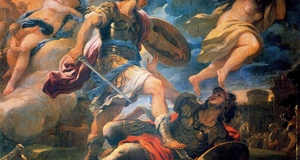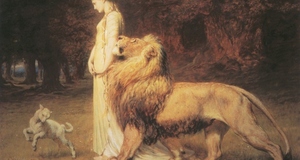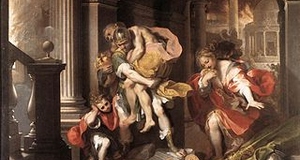From Inquiries Journal: Special Editions VOL. 2020 NO. 1Exploring the Concept of Time Using Metaphor in The Aeneid
By
Inquiries Journal: Special Editions 2020, Vol. 2020 No. 1 | pg. 1/1 AbstractTime has always been an abstract concept in human languages. To better understand how this temporal concept is addressed in different languages, it can be explored in the context of classical times through Latin texts. In the well-known piece The Aeneid, the author Virgil constantly refers to the concept of time in an overlapping timeline and we can interpret the intertwined timeline through figuration, substitution and action. This use of metaphors to visualize the abstract temporal concept is evident in classical Latin literature and thus can be expanded to the Latin context and even modern European languages. This paper analyzes lines 250-297 in book 2 of The Aeneid, in order to showcase how multiple layers of time are clarified by the author. This paper addresses the concept of time through metaphors. It is known that time is an abstract concept. People have been used many different ways to perceive this abstract concept in order to make it a concrete image that can be easily understood. According to Lakoff, “time is money” is a metaphor that substitutes time with a concrete concept “money,” using the characteristic of time as a valuable commodity. However, the concept of time is best explored through original Latin text. One key text to analyze is The Aeneid, which was influential in Latin literature and was also widely read by Romans, shaping their thoughts. One key feature of The Aeneid is time, mainly demonstrated through memories and prophecies. According to William Franke, in book 6, Virgil “enables the future to react upon the past and present,” as Aeneas travels to the underworld to view the prophecy of his future. In order to do so, Virgil “transcends the limitations of linear time.” Similarly, in book 2, from line 250-297, the author showcases the climax of the Trojan War through the recalling of Aeneas’ memory. However, what makes this section crucial to the plot development is the prophecy of Hector that predicts the future. This intertwined timeline makes it all the more crucial to employ a concrete metaphor to clarify this abstract concept of time. In line 250, “Vertitur interea caelum et ruit oceano nox,” meaning “meanwhile, the sky turns up, and the night falls down on the ocean” demonstrates a use of personification, formulating the image of “the change of time” as the motion of “umbra magnus” (2.251), “great shadow.” In this line, the key verbs indicative of a personification are “vertitur” and “ruit.” “Vertitur” being placed at the head of this line is an emphasis on this motion. Moreover, the word “vertitur” is the third person indicative passive, so the meaning is “being turned up.” On the other hand, “ruit” is a third person indicative active, meaning “falls down.” The two words together elaborate that “day” is in a passive state, being manipulated and forced to leave the sight of men, and “night” is voluntary in falling down on earth. Here, this passage of time at dusk is being perceived as two distinct yet correlative motions acting together, “day being forced to leavethe sky” and “night falling down.” Virgil is only describing the change of time at one specific period of time — nightfall. Yet, this rotative motion of day and night in the sky could be expanded to the whole day, which gives this abstract movement of time a clear concrete metaphor of a shadow moving over the sky in a rotative motion that changes between night and day. Virgil’s use of this rotative motion also exists in other cultures, which addresses a key characteristic of an abstract feature of “time” which is reversibility. As, in a rotative motion of night and day, whether it is “clockwise” from night to day or “anticlockwise” from day to night, the results are the same. So, this metaphor of using a rotative motion to substitute the basic phenomenon of night and day is actually fulfilling this vagueness of the direction of this movement. Virgil also uses tense as a substitution for both present and future in the prophecy of Hector from lines 288 to 295 in book 2, marking a distinction between the present and the future. In the prophecy, Hector gives clear instructions to Aeneas by using verbs such as “fuge” (flee), “eripe” (take away), “cape” (seize) and “quaere” (look for), which are all in second person present imperative, delivering a demand to Aeneas, informing him to escape this chaotic city of Troy and take the household gods with him. Yet, in this prophecy there is one verb that is not in second person present imperative but in second person future indicative. This word is “statues,” meaning “establish.” Looking back on this prophecy of Hector, it is obvious that the only “prophetic” statement is this sentence with the word “statues”.” After transforming this sentence from poetry to prose, it is “his moenia magna quaere, quae pererrato ponto denique statues,” which is a clause that concludes this book The Aeneid. The first half of the sentence “moenia magna quaere,” which means “seek great walls,” is a summary of The Aeneid after book 6, while the second half of the sentence “quae pererrato ponto denique,” which means “after wandering the seas,” is the summary of The Aeneid before book 6. In order to understand this metaphor, we have to understand the main theory “similarity connects a metaphorical term with the term for which it is substituted,” according to Jakobson, which states that the key of metaphors is substitution. Thus, tenses are a substitution of time, which in any language, ubiquitously exists. In this case, in a complicated prophecy placed within memory, the author Virgil places a clause inside this section that summarizes the whole book, while clearly using the present as a clear statement of memory and the future indicative as a implication of the prophecy in the past when Hector is delivering this message, as well as the present when Aeneas is recalling this memory. The main theme of this section is the prophecy of Hector, which is delivered through multiple levels of narration in order to convey the sense of time. As mentioned, this is a prophecy in the context of recalling Aeneas' memory, which would encompass different layers of time. The author Virgil is also using different layers of narrators to clarify these different timelines. In line 271, Virgil uses the word “visus” meaning “have seen” describing the action of Aeneas when Hector comes to him in his dream, thus necessitating the description of his figure. First describing his figure as “aterque cruento pulvere” (his body black with dust) and then providing more details on his hair and beard, as in “squalentem barbam et concretos sanguine crinis” (his matted beard and his hair filthy with blood). This description of a battered Hector who bears scars and marks of sacrifice and war is not directly influential to him delivering this prophecy. However, the author describes him in detail. The reason for this is, in Roman mythology, people come to the underworld after death but remain in the form of the human, and also gain the ability to foresee the future on a different scale of time. Moreover, the figure of Hector is that of him losing a duel to Achilles, which in turn emphasizes the cruciality of this lost battle against Achilles to Troy. Besides that, most importantly, in this case, Virgil needs a human figure to directly state the prophecy, so that the double layer of time is clear. Time is already an abstract concept, and prophecy is a message, that is hard to perceive. With the prophecy always delivered by the gods, there is a need for a messenger to deliver it to humankind. Thus, this one human figure acting as the messenger is always crucial. In this case, it is the spirit of Hector in Aeneas’ dream. The author Virgil uses lines of descriptive language to portray Hector in order to form this clear human-like figure. Moreover, Virgil emphasizes on the fact that Aeneas “visus” (saw) Hector in his dream, by placing the word “visus” at the beginning of line 271. In this short section of The Aeneid, the author is trying to deliver a prophecy in a memoir, making this intertwined timeline more difficult to comprehend. Thus, Virgil uses the unique endings and free placements of words in Latin Grammar to express that Aeneas saw Hector coming into his dreams, giving him orders to escape in present tense, and prophesizing the plot of the book in future tense. Thus the distinctive layers of time are shown through the elaborate diction and syntax of Virgil. As people developed languages to deliver messages, some concepts are concrete yet some are abstract. Through this analysis of lines 250-297, in book 2 of The Aeneid, the concept of time is shown to the reader through actions, substitutions and figures that could be perceived by the common people. The use of concrete concepts to explain an abstract term such as time is ubiquitous in all languages and the discussion of Latin could be a broad reflection of many modern Indo-European languages. In this short essay, only approximately 40 lines were discussed, yet many other details could be uncovered about this statement throughout The Aeneid (such as book 6) and also many other modern and classic texts. ReferencesAhl, Frederick, Virgil’s Aeneid, Oxford, Oxford University Press, 2007 Franke, William, On Doing the Truth in Time, Trustees of Boston University, http://www.jstosr.com/stable41308592 Jakobson, Roman, “Selections: The Metaphoric and Metonymic Poles,” http://individual.utoronto.ca/bmclean/hermeneutics/jakobson_suppl/jakobson_metaphoric_metonymic.htm Lakoff, George, Metaphors We Live By, Chicago, The University of Chicago Press, 1980 Suggested Reading from Inquiries Journal
Inquiries Journal provides undergraduate and graduate students around the world a platform for the wide dissemination of academic work over a range of core disciplines. Representing the work of students from hundreds of institutions around the globe, Inquiries Journal's large database of academic articles is completely free. Learn more | Blog | Submit Latest in Literature |

















